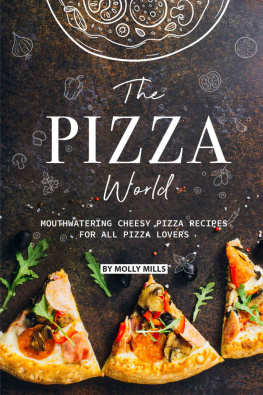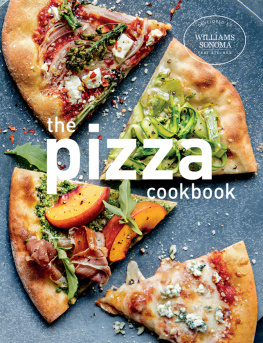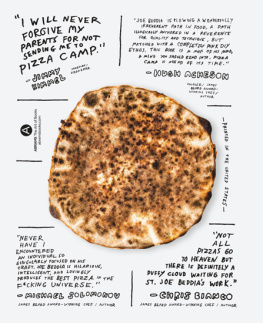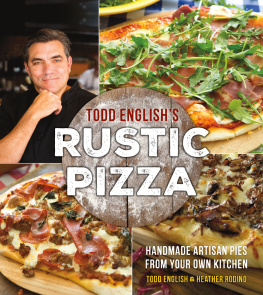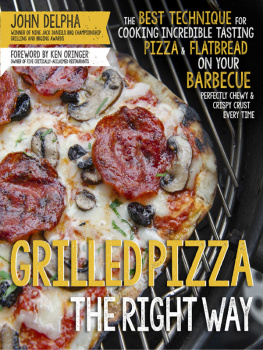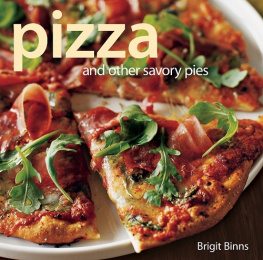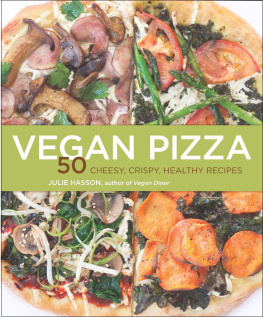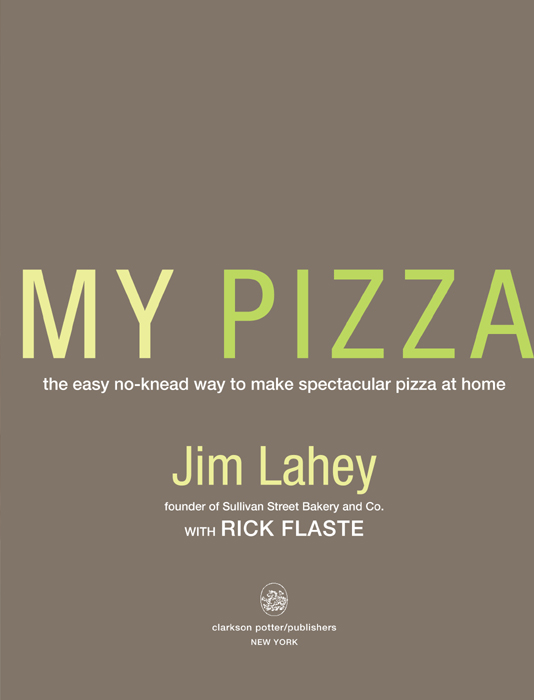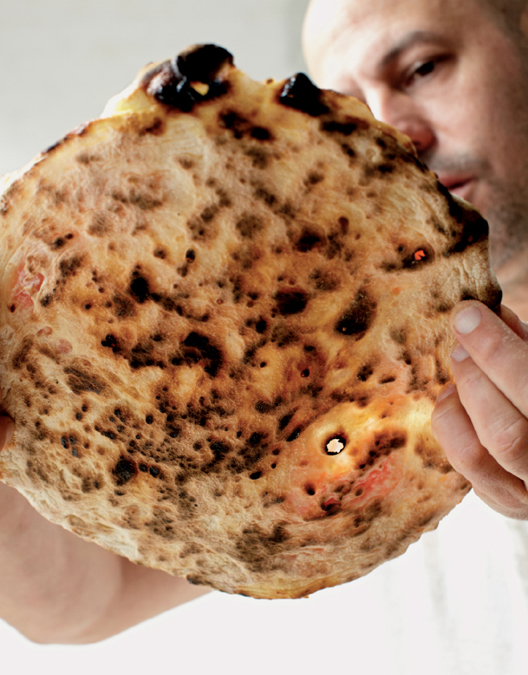
Copyright 2012 by Jim Lahey
Photographs copyright 2012 by Squire Fox
All rights reserved.
Published in the United States by Clarkson Potter/Publishers, an imprint of the Crown Publishing Group, a division of Random House, Inc., New York.
www.crownpublishing.com
www.clarksonpotter.com
CLARKSON POTTER is a trademark and POTTER with colophon is a registered trademark of Random House, Inc.
Library of Congress Cataloging-in-Publication Data
Lahey, Jim.
My pizza / Jim Lahey with Rick Flaste. 1st ed.
Includes index.
1. Pizza. I. Flaste, Rick. II. Title.
TX770.P58L34 2012
641.8248dc23 2011019842
eISBN: 978-0-307-95323-0
Jacket design by Stephanie Huntwork
Interior and jacket photography by Squire Fox
v3.1
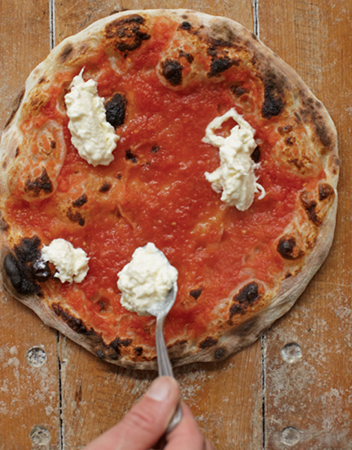
Dedicated in loving memory
to my dad,
DICK LAHEY
CONTENTS

INTRODUCTION
In the early days of my Manhattan pizza restaurant, a middle-aged woman came through the front door, her eyes widened by the crowd that had been drawn to the place even before it had officially opened. She was wearing a huge white hairy coatwhich meant she was going to take up about two spots at one of the long communal tables. She wedged herself in and ordered a pieI think it was a Margheritaand as soon as it arrived she called over the manager. She told him that nothing about the pizza was the way it was supposed to be. It had too little sauce, she said. The crust was too dark, and it was too firm besides.
As anyone who has baked from my book My Breadbased on my method for a stunningly easy, rustic no-knead loafalready knows, I usually diverge from the well-worn road and travel my own way.
Thats not to say that, in creating my pizzas, Im coming to them without an authentic background. Ive spent many months traveling throughout Italy, always learning as I go, searching for the bread and pizza standards that appeal most to my own sensibility, my palate, and my strong (some would say headstrong) feelings about the art of cooking and baking. My first trip to Rome just blew me awaythe beauty, the produce, the bread. Of course, Ive also been to Naples (the Italian pizzas heartland), but I definitely dont want you to think this book is some kind of grab-bag of Neapolitan pizzas. As much as I admire the intense appreciation for ingredients there, I have frequently been disappointed by the pizzas, many of which appeal to a tourist-grade lowest common denominator. In a nation of such beauty andin the good timesaffluence, Naples has stood out too regularly for its episodes of crime and poverty. Too many pizza bakers dont worry much about whether the tomatoes in the sauce are the best, as long as they are cheap; the mozzarella they choose is too often of poor quality, lacking in moisture. They dont bother to give the dough time enough to ferment properly, settling for a mediocre crust.
Pizza deserves respect and admirationfor everything about it, but especially the bread, the crust. As a former art student who turned to baking, I see a pizza crust as a canvas, an invitation to paint and sculpt with food. I hope that doesnt sound too pretentious; pizza is after all a peasant food, but a glorious peasant food when someone approaches it with care and affection, taking bread and building it into a beautiful whole meal.
As much carping as Ive just done about Naples, I have to say it is pizza paradise compared to the United States. If you choose carefully, you can find great pizza in Naples. Back home, however, I want to weep when I think how industrialized (with a few exceptions) this simple food has become. Many Americans grow up with the notion that real pizza is the stuff they box at Pizza Hut or Dominospizza for which the greatest objective seems to be how fast a truck can get it to ones door. Or its a notion formed by the so-called pizza parlor. Isnt a parlor supposed to suggest a pleasant place where bright people gather to talk, enjoy each others company, share ideas? A beauty parlor offers more creativity than your average American pizza parlor, a garish, harried place where floppy pies made from trashy ingredients are turned out over and over againuntil customers are persuaded that this experience is somehow a good thing.
Ive been fortunate enough to find and learn from the genuine article in many places. In Naples, when you manage to squeeze past all the bad stuff, there is Da Michele, a nondescript yet renowned and worshipped place that seems to reserve all its skill for selecting the purest, freshest ingredients and then assembling them basically, without pretension. I also learned from Chris Bianco, the award-winning chef at Pizzeria Bianco in Phoenix, who puts most boastful New Yorkers to shame, and from the inventive Andrew Feinberg at Frannys in Brooklyn. They are all wonderfully expert in their personal ways, and the education they shared with me helped put me on the path to making pizza my way.
I came to pizza baking slowly. First, I was a bread baker. And in some ways bread saved my life. It fulfilled so many needs, gave me purpose, allowed me to indulge a talent that I must have had in me all along. I opened Sullivan Street Bakery in New York Citys SoHo neighborhood in 1994; in the fall of 2000, we moved the bakery to a larger location in Hells Kitchen. As I struggled through my early mornings, year after year, I was always learning and inventing. Along the way, I developed my no-knead home-kitchen process for dough that, once risen, is cooked in a preheated pot in the oven; the pot acts as an oven within an oven, creating a dark, rustic crust while at the same time keeping the crumb moist. A little yeast and extended fermentation strengthen the dough, eliminating the kneading step thats supposed to do the same thing. Its a method that ultimately brought me widespread recognitionin large part thanks to Mark Bittmans article about it in the New York Times, a piece that, on the wings of the Internet, flew around the world so fast and so far that even Mark was startled. That was in 2006.
But, earlier, soon after September 11, I got the idea that Id like to do something to cheer people up. On New Years Day, while gloom still gripped the city, I decided to act on it: I threw a pizza party at the bakery. I made pizzas that were round, charred at the edge, and relatively firm on the bottom (I dont like soft crusts with the toppings sliding off). It was too soon to think about using my no-knead dough, an approach that hadnt advanced far enough yet. That would come later (and is now in fact the foundation of my crusts). I invited friends, chefs, and customers. And the party caught on. I threw that party every New Years for four years.
I was a baker, not a chef, and yet I got it in my head that I wanted to be able to show off a bit more of my cooking skills beyond bread makingas much as I do revere it. So I persuaded a friend who had a pizza truck to go with me to Union Square, the great farmers market in the city. The pizzas I made thereand gave away free, which admittedly is always a surefire approachwere simple: the Rosa, a Margherita, and the spinach pizza I call a Popeye, all of which youll see in this book. The hungry natives lined up five deep. I also gave away T-shirts that shouted Viva Hells Kitchen to announce the bakerys new address.


